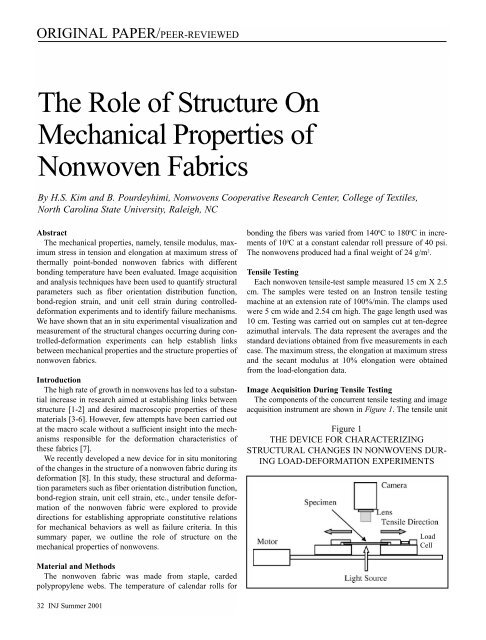2001 - Volume 2 - Journal of Engineered Fibers and Fabrics
2001 - Volume 2 - Journal of Engineered Fibers and Fabrics
2001 - Volume 2 - Journal of Engineered Fibers and Fabrics
You also want an ePaper? Increase the reach of your titles
YUMPU automatically turns print PDFs into web optimized ePapers that Google loves.
ORIGINAL PAPER/PEER-REVIEWED<br />
The Role <strong>of</strong> Structure On<br />
Mechanical Properties <strong>of</strong><br />
Nonwoven <strong>Fabrics</strong><br />
By H.S. Kim <strong>and</strong> B. Pourdeyhimi, Nonwovens Cooperative Research Center, College <strong>of</strong> Textiles,<br />
North Carolina State University, Raleigh, NC<br />
Abstract<br />
The mechanical properties, namely, tensile modulus, maximum<br />
stress in tension <strong>and</strong> elongation at maximum stress <strong>of</strong><br />
thermally point-bonded nonwoven fabrics with different<br />
bonding temperature have been evaluated. Image acquisition<br />
<strong>and</strong> analysis techniques have been used to quantify structural<br />
parameters such as fiber orientation distribution function,<br />
bond-region strain, <strong>and</strong> unit cell strain during controlleddeformation<br />
experiments <strong>and</strong> to identify failure mechanisms.<br />
We have shown that an in situ experimental visualization <strong>and</strong><br />
measurement <strong>of</strong> the structural changes occurring during controlled-deformation<br />
experiments can help establish links<br />
between mechanical properties <strong>and</strong> the structure properties <strong>of</strong><br />
nonwoven fabrics.<br />
Introduction<br />
The high rate <strong>of</strong> growth in nonwovens has led to a substantial<br />
increase in research aimed at establishing links between<br />
structure [1-2] <strong>and</strong> desired macroscopic properties <strong>of</strong> these<br />
materials [3-6]. However, few attempts have been carried out<br />
at the macro scale without a sufficient insight into the mechanisms<br />
responsible for the deformation characteristics <strong>of</strong><br />
these fabrics [7].<br />
We recently developed a new device for in situ monitoring<br />
<strong>of</strong> the changes in the structure <strong>of</strong> a nonwoven fabric during its<br />
deformation [8]. In this study, these structural <strong>and</strong> deformation<br />
parameters such as fiber orientation distribution function,<br />
bond-region strain, unit cell strain, etc., under tensile deformation<br />
<strong>of</strong> the nonwoven fabric were explored to provide<br />
directions for establishing appropriate constitutive relations<br />
for mechanical behaviors as well as failure criteria. In this<br />
summary paper, we outline the role <strong>of</strong> structure on the<br />
mechanical properties <strong>of</strong> nonwovens.<br />
bonding the fibers was varied from 140 0 C to 180 0 C in increments<br />
<strong>of</strong> 10 0 C at a constant calendar roll pressure <strong>of</strong> 40 psi.<br />
The nonwovens produced had a final weight <strong>of</strong> 24 g/m 2 .<br />
Tensile Testing<br />
Each nonwoven tensile-test sample measured 15 cm X 2.5<br />
cm. The samples were tested on an Instron tensile testing<br />
machine at an extension rate <strong>of</strong> 100%/min. The clamps used<br />
were 5 cm wide <strong>and</strong> 2.54 cm high. The gage length used was<br />
10 cm. Testing was carried out on samples cut at ten-degree<br />
azimuthal intervals. The data represent the averages <strong>and</strong> the<br />
st<strong>and</strong>ard deviations obtained from five measurements in each<br />
case. The maximum stress, the elongation at maximum stress<br />
<strong>and</strong> the secant modulus at 10% elongation were obtained<br />
from the load-elongation data.<br />
Image Acquisition During Tensile Testing<br />
The components <strong>of</strong> the concurrent tensile testing <strong>and</strong> image<br />
acquisition instrument are shown in Figure 1. The tensile unit<br />
Figure 1<br />
THE DEVICE FOR CHARACTERIZING<br />
STRUCTURAL CHANGES IN NONWOVENS DUR-<br />
ING LOAD-DEFORMATION EXPERIMENTS<br />
Load<br />
Cell<br />
Material <strong>and</strong> Methods<br />
The nonwoven fabric was made from staple, carded<br />
polypropylene webs. The temperature <strong>of</strong> calendar rolls for<br />
32 INJ Summer <strong>2001</strong>
















